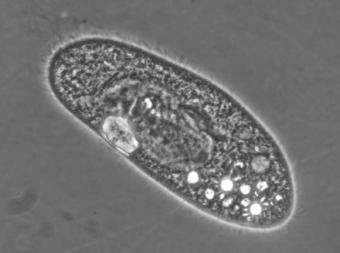

<b>A counterintuitive phenomenon</b>
The paramecium, normally a responsive swimmer, appears not to use its sensory network for navigation under certain circumstances. When in evolutionary history did active navigation become an advantage?
For such humble creatures, single-celled paramecia have remarkable sensory systems. Give them a sharp jab on the nose, they back up and swim away. Jab them in the behind, they speed up their swimming to escape. But according to new research, when paramecia encounter flat surfaces, they’re at the mercy of the laws of physics.
The findings, published in the journal Physical Review Letters, come from some surprising results in research performed in recent years by James Valles, professor and chair of physics at Brown University, and his students.
The group has been working to understand how paramecia react to changes in their buoyancy. The experiments are done by adding tiny magnetic particles to the water in which the creatures swim, and then applying a powerful magnet. When the water is pulled downward by the magnet, the paramecia become more buoyant and float more easily. Pull the water up, and the creatures become less buoyant.
The initial research, published a few years ago, showed that paramecia have a remarkable ability to sense the changes in their buoyancy and adjust their swimming behavior accordingly.
“We found that if we made them sink more by making them less buoyant, they would try to swim harder against that sinking,” Valles said. The effect was the same when the creatures were made more buoyant; they swam harder against the tendency to float.
But over the course of the experiments, a strange thing happened. When their buoyancy was increased, meaning the paramecia should float more easily, the creatures would eventually get stuck to the lower surface of their enclosure. When the researchers reversed the experiment, making the paramecia less buoyant, they got stuck at the top.
“It was so striking,” said Valles, who performed the latest experiments with graduate student Ilyong Jung and Karine Guevorkian of the Institut de Génétique et de Biologie Moléculaire et Cellulaire in France. “They looked like bats hanging from the top of a cave.”
To understand this counterintuitive phenomenon, Valles and his colleagues watched paramecia swim into surfaces both under normal buoyancy as well as with buoyancy altered. Under normal circumstances, the paramecia skitter along the surface briefly before turning and swimming away. But when buoyancy was increased, they failed to complete the turn, leaving them stuck at an angle against the lower surface.
The researchers determined that what they were seeing could be explained entirely by Newton’s Third Law of Motion. When the creatures push against a surface, the surface pushes back with equal force. Under normal circumstances that force is enough to cause the creatures to turn, enabling them to swim away. But when their buoyancy is increased, paramecia don’t hit the lower surface with as much force, which means the force applied back to them is also reduced.
“As they turn, that force of the wall acting on them gets smaller and smaller because they’re swimming at an angle against the surface,” Valles said. “It turns out that when buoyancy is altered, there’s an angle at which that force goes to zero before they complete the turn.”
And so there they stay, stuck at that angle against the surface.
The results are surprising, Valles said, because it implies that paramecia don’t respond to contact with surfaces by actively changing their swimming behavior — even though they have the ability to respond actively when poked and prodded.
“Paramecia are interesting to people because they’re like swimming nerve cells — they have this surprisingly complex force-sensing network,” Valles said. “But it appears as if it’s not necessary for them to use it for simple navigation.”
The findings raise some interesting evolutionary questions, Valles said.
“Fish and other higher organisms actively navigate,” he said. “But being passive apparently works just fine for paramecia; they’re in every pond you come across. The question that’s interesting to me is when in evolutionary history did a more active navigation become advantageous?”
Note to Editors:
Editors: Brown University has a fiber link television studio available for domestic and international live and taped interviews, and maintains an ISDN line for radio interviews. For more information, call (401) 863-2476.












